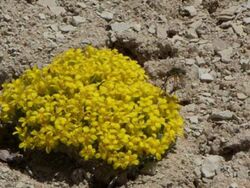Biology:Physaria tumulosa
| Physaria tumulosa | |
|---|---|

| |
| Scientific classification | |
| Kingdom: | Plantae |
| Clade: | Tracheophytes |
| Clade: | Angiosperms |
| Clade: | Eudicots |
| Clade: | Rosids |
| Order: | Brassicales |
| Family: | Brassicaceae |
| Genus: | Physaria |
| Species: | P. tumulosa
|
| Binomial name | |
| Physaria tumulosa (Barneby) O'Kane & Al-Shehbaz
| |
| Synonyms | |
|
Lesquerella tumulosa | |
Physaria tumulosa is a rare species of flowering plant in the family Brassicaceae known by the common name Kodachrome bladderpod. It is endemic to Utah in the United States, where it is known only from Kane County.[1] There is only one known population of this plant made up of scattered occurrences totalling about 20,000 individuals, all within the Kodachrome Basin.[2] The plant is threatened by the loss and degradation of its habitat.[1] It is federally listed as an endangered species. It was previously treated as a subspecies of Physaria hitchcockii.[3]
This is a perennial herb producing short stems from a buried caudex and forming a tough mat just a few centimeters tall. The mat has hairy, somewhat fleshy leaves which are linear or lance-shaped and up to 1.2 centimeters long. The inflorescence is a crowded raceme of bright yellow flowers. The fruit is an inflated silique a few millimeters wide.[3][4]
The single known population of this plant is mostly located on land within the bounds of the Grand Staircase–Escalante National Monument and Kodachrome Basin State Park. It grows on dry outcrops of white shale at roughly 1,740 meters (5,710 feet) in elevation. The rock is part of the Carmel geologic formation. The plant is commonly associated with buckbrush (Purshia tridentata) and yellow cryptantha (Cryptantha flava), but it grows on bare rocky substrate with little other vegetation.[2]
This plant is a narrow endemic which is limited in distribution, and the land on which it grows is impacted by a number of processes. The main threat to the species is off-road vehicle use.[2] The vehicles cause soil degradation, erosion, and plant mortality. Gravel mining was a threat to the species but since the area was designated a national monument these operations have ceased.[2]
References
- ↑ 1.0 1.1 Lesquerella tumulosa. The Nature Conservancy.
- ↑ 2.0 2.1 2.2 2.3 USFWS. Lesquerella tumulosa Final Recovery Outline. October 2009.
- ↑ 3.0 3.1 Physaria tumulosa. Flora of North America.
- ↑ USFWS. Final rule to determine a Utah plant, Lesquerella tumulosa (Kodachrome Bladderpod) as an endangered species. Federal Register October 6, 1993.
Wikidata ☰ Q15372808 entry
 |


